![]()
![]()
![]()
Use LEFT and RIGHT arrow keys to navigate between flashcards;
Use UP and DOWN arrow keys to flip the card;
H to show hint;
A reads text to speech;
10 Cards in this Set
- Front
- Back
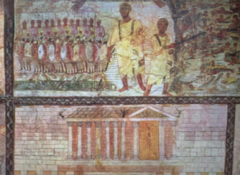
|
Synagogue at Dura-Europos (244-245), Syria --courtyard, assembly area, separate area for women (renovation then let men and women congregate together) --biblical stories wrap around the room in the narrative roman tradition of official historical story-telling (paintings show parting and unparting of the red sea with gods hand clear in both, showing his divine presence in every miracle) --use of hieratic scale --bench along the walls and niche for Torah scrolls |
|

|
Synagogue at Beth Alpha (6th century, Israel) --mosaic floor w geometric pattern (but figural and symbolic compositions in the middle) --three naves, vestibule, and courtyard --near eastern and classical influence |
|
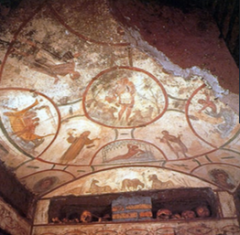
|
SS. Pietro e Marcellino (4th century)--ceiling detail --shows story of jonah and the sea monster where he is swallowed and spat out after three days (allegory for resurrection of christ) --depicts christians buried within those very walls --central medallion with four semicircular lunettes framed by arches |
|
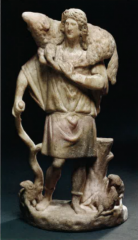
|
The Good Shepherd (250-300) --can be see at the catacombs or Marcellino --harks back to story of Jonah again and jesus's promise to be the good shepherd |
|
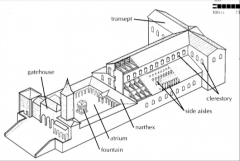
|
Old St Peter's Basilica (333) --what st. peter's basilica used to be like --gatehouse leadings into fountain and atrium area, side aisles around the nave leading to transept with clerestory lighting --nave ends with an arch that shows Constantine and St. Peter presenting a model of the church to christ for his approval |
|

|
Oratory of Galla Placidia, Ravenna (425) --image of christ as a shepherd (symbol of the shepherd definitely used across cultures) --sort of made in the guise of constantine (shares a lot of his features) --good shepherd mosaic --a more regal depiction of jesus (which makes sense if he's being compared to constantine) where he isn't really doing hard work, but rather sitting in a robe among his flock adorned w a hallow (effortlessness in his divinity) --realism begins to be sacrificed for iconography: welcome to the middle ages |
|
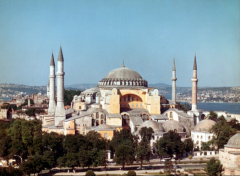
|
Anthemius and Isidorus, Hagia Sophia, Istanbul, 532-537 --so many windows where light can come through --during rain of justinian, early byzantine --"the church of holy wisdom" --4 towering minorets were not there at the time of justinians creation, added later by the turks (turned it from a church to a mosque) --humongous building, huge dome --unassuming outside, amazing inside w so many colors and the LIGHT WOW!!!! (illusion that the dome is resting on light), the light "transforms substance into an abstract spiritual vision" --formed using pendentives --dome combined w long horizontal building, like the parthenon, feat of building (essentially a domed basilica) --used brick instead of concrete (distinctly byzantine) --Greek orthodox --nave was for clergy, not congregation --CHURCH AND STATE ARE ONE! --size of rome, mystery of catholocism |
|
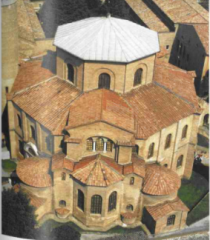
|
San Vitale, Ravenna, 547 --construction began by Bishop Eclesius --centrally planned --two concentric octagons (inner forms the interior w clerestory lighting) --mosaic theme is holy ratification of justinian's right to rule --solidifies emperor as proprietor of the church, shows him presenting plans to jesus for approval --procession taking place in san vitale, jesus and justinian united by purple on robes --placement is purposefully vague, floating, divine --loses the squatness of early christian, more elegant figures --divine are invisible (this image is just to stimulate religion, not to necessarily tell a story --BYZANTINE ART IS NOT REALISTIC, THE SKY ISN'T GOLD (disparages matter and material values) --image of theodora as well leading a similar procession (didn't have to do this, shows that she's his right hand man, sort of like nefertiti and akhenaten) --neither of them were ever here, complete fiction --3 magi on her robe show that she belongs w people who offered gifts to christ |
|
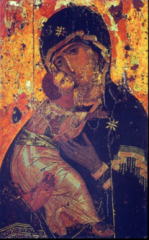
|
Virgin of Vladimir (11th-12th century) --rejection of iconoclasm --middle byzantine --stylized abstraction from years of working and reworking --all the hallmarks of a byzantine icon (long straight nose, small mouth, gold sky and robes, unbroken contour holding the two together --virgin of compassion, pressing cheek to son caring --symbol of byzantium's cultural and religious mission to the slavic world |
|
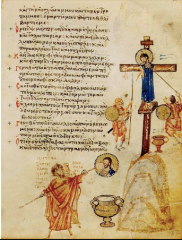
|
Khludov Psalter (9th century) --destruction of icons equivalent to torture of christ |

